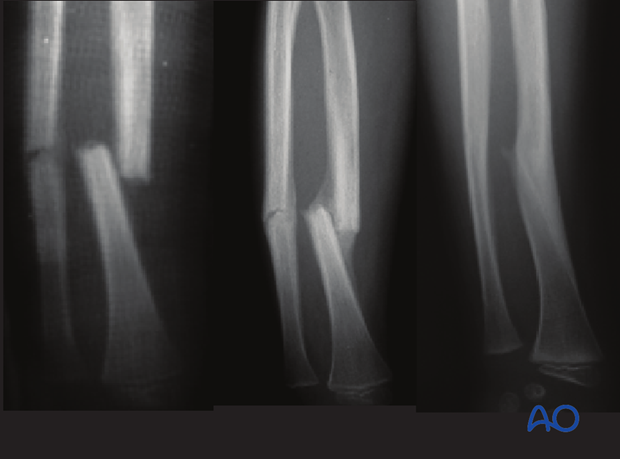Age-related modeling capacity
1. Factors affecting modeling potential
Four major factors have a bearing on the potential for angular modeling:
- Skeletal age
- Individual potential of a specific growth plate (eg proximal humerus > distal humerus)
- Proximity to the joint
- Orientation to the axis of the joint

2. Potential to model
In the upper extremity, longitudinal growth mainly occurs at the proximal humerus and distal radius/ulna (the shoulder and wrist, respectively).
The growth centers of the upper humerus and distal radius and ulna account for most growth in the extremity. The modeling potential in these areas is therefore considerable.
Fractures around the elbow, especially the distal humerus, however, have much less modeling potential.
The proximal ulna is an apophysis and has no real growth plate responsible for longitudinal growth. This is the reason why Monteggia lesions with fracture or bowing of the proximal ulna have a low modeling capacity.
3. Guidelines for acceptable malalignment after nonoperative treatment
Evidence to support these guidelines is weak and considerable variation exists between surgeons when deciding between operative and nonoperative management.
The following recommendations are however generally accepted.
Acceptable deformity/displacement
9 years of age and under:
- Under 15° of angular deformity
- Bayonet apposition (100% translation) acceptable if interosseous gap maintained
10 years of age and older:
- Anatomic reduction preferred
- Under 10° of angular deformity acceptable
- Bayonet apposition (100% translation) acceptable if interosseous gap maintained
Note: Control of angulation and rotation and maintenance of an adequate interosseous gap in a cast is difficult with bayonet apposition and is a relative indication for operative management especially in older children with this fracture pattern.
Note: Older texts contain recommendations about allowable degrees of rotational malalignment. This is extremely difficult to judge. If there is obvious rotational malalignment, then careful consideration should be given to remanipulation or operative intervention.













